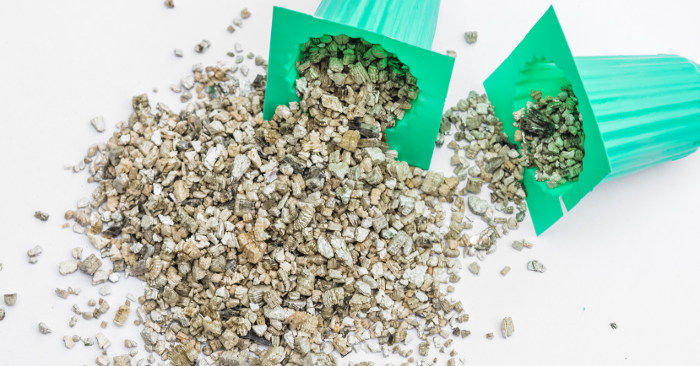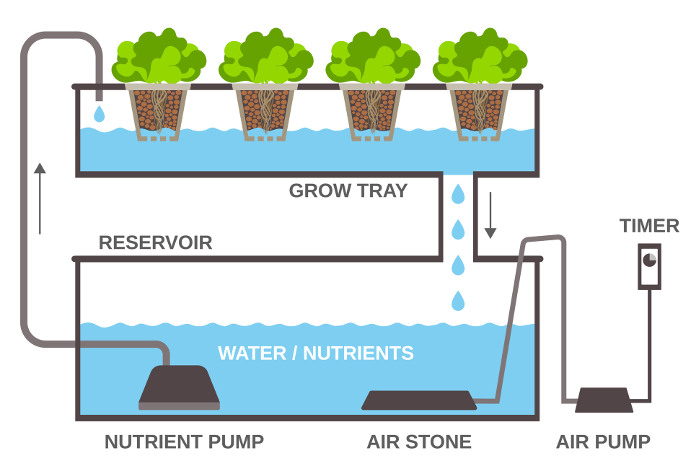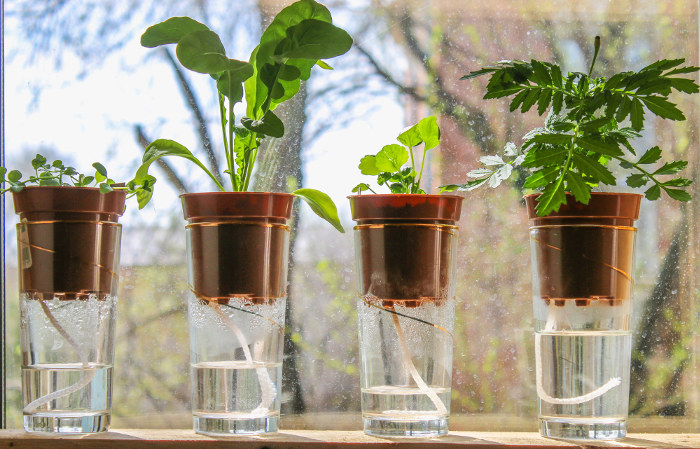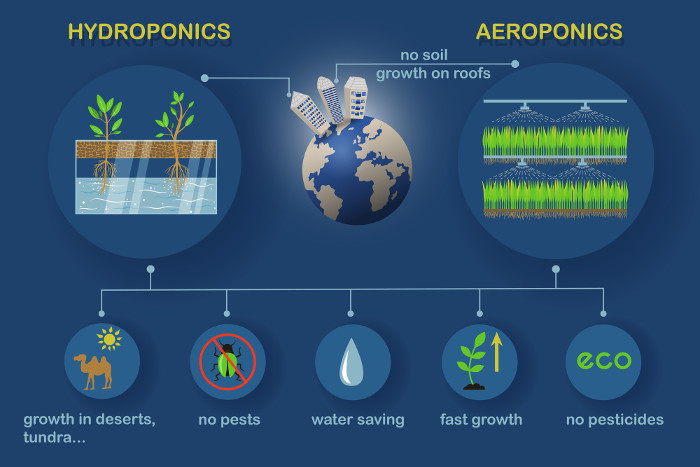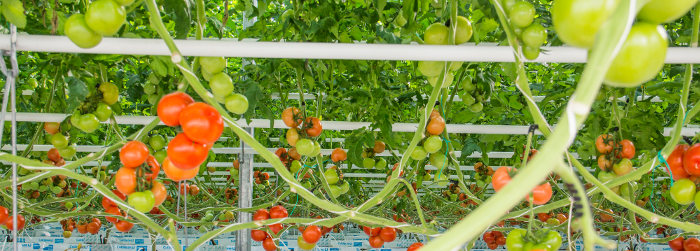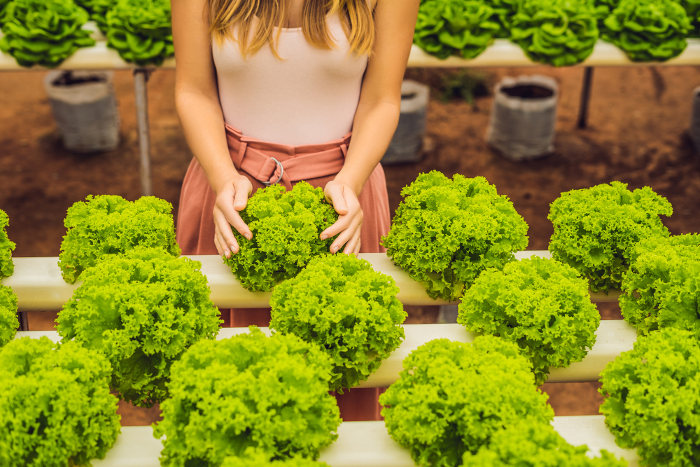Very few things can give as much satisfaction as growing your own food, but unfortunately, not everyone has the advantage of owning a garden plot, field or homestead. Appropriate land can be difficult to come by, particularly in urban areas, which is one reason why so many people have turned to hydroponic gardening. With this unique method of growing, no land is necessary, and you can cultivate your own herbs, fruits and vegetables. Some people buy ready-made hydroponic kits and others want to build their own system.
Hydroponic Herb Garden
An indoor hydroponic herb garden is a popular choice for people looking to get started with hydroponics. It takes a small amount of space and it’s a great winter activity enjoyed by the entire family. The herbs are protected from the cold and garden fresh herbs used in recipes make winter dishes tasty and healthy.
Herbs may be one variety of plants that benefits most from hydroponic gardening. Studies have shown hydroponically grown herbs contain 20 to 40% more aromatic oils than their traditionally grown counterparts, which can raise simple, home-grown herbs to gourmet status.
The video below features a woman living in New York city who demonstrates how to grow a herb garden while living in an apartment with a hydroponic system available for purchase on Amazon.com. The kit and supplies seen in the video are below.

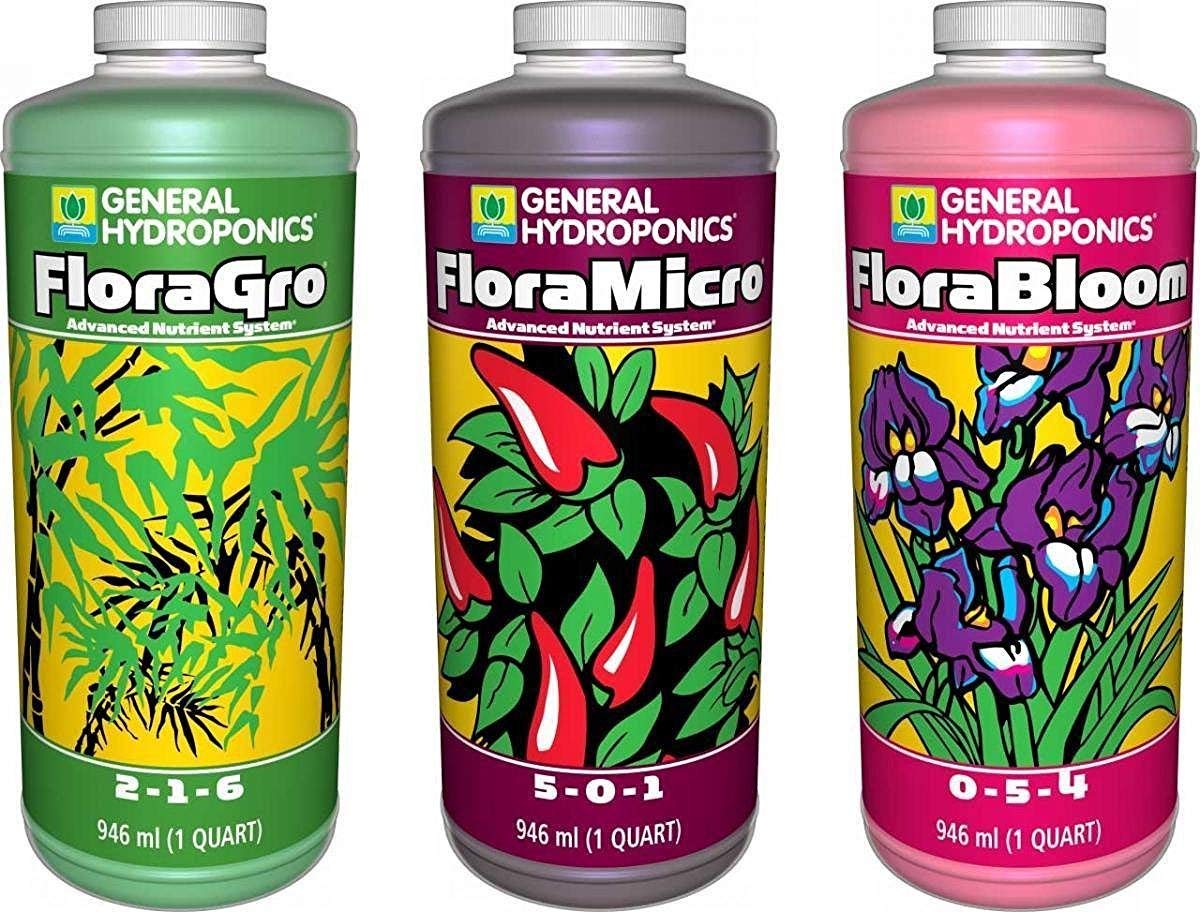
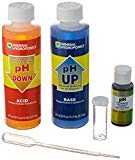
A number of herbs do well if grown hydroponically, among them figuring basil, mint, rosemary, lemon verbena, parsely, oregano, thyme, and cilantro. Even stevia rebaudiana and Echinacea do well in a hydroponic garden. Just be sure to use seedlings rather than seeds for stronger, faster-growing plants.
Nutritionally, herbs need more nitrogen than phosphorous, although both are important to their health. They also require an EC of 1.2 to 1.8 and a pH around 5.8 to 6.4. 70 to 75 degrees Fahrenheit (about 21 to 24 degrees Celsius) are ideal, but herbs can rough it occasionally and still do well. In fact, they often produce better results when their growing conditions are not constantly perfect.
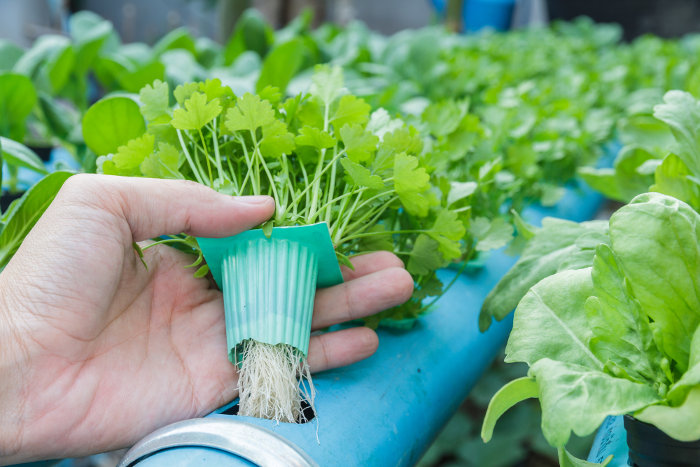
When providing light, keep your artificial bulbs about a foot away from the herbs as they grow. The best kind of light to use is a metal halide light. This will give the herbs the complete light spectrum, especially on the blue end.
For extra effectiveness, equip your herb garden with an oscillating fan. This will increase exposure to carbon dioxide and thereby promote photosynthesis. You also want to keep the humidity somewhere between 40 and 60%, using artificial means if necessary.
What is Hydroponic Gardening?
Hydroponic gardens can vary widely, but they share a few traits in common. In a hydroponic garden, for example, you do not use soil at all. Instead, you grow your plants alone or in a substrate such as rockwool, perlite, vermiculite, peat moss, or coconut coir. The substrate is inert, meaning it does not break down easily and affect the nutrients and pH levels.
Hydroponic gardens require nutrients and oxygen, of course, as do traditionally grown foods. However, the difference here is that you apply them by one of various methods directly to the roots or to the substrate, which then carries them to the roots. The roots, therefore, do not have to gather and absorb the nutrients from soil, thereby conserving energy which expends itself in the development of the plants.
All hydroponic gardens also need light, whether it be artificial or natural. Photosynthesis can’t occur without light, so every hydroponic garden must take this into account. Metal halide is the most popular kind of artificial light, but you can also use fluorescent lights, LEDs, and high-pressure sodium bulbs.
You can build your own DIY hydroponics garden in your apartment or other small urban indoor space. Although outdoor hydroponic gardens are also popular. The video below shows a homemade DIY hydroponic gardening system with 130 plants growing including lettuce, cabbage and kale in just ten square feet!
Advantages and Disadvantages of Hydroponic Gardening
Advantages
Some of the positive attributes of hydroponic gardening are quite distinctive, while others are somewhat more obscure. One of the most obvious advantages is the absence of a need for land or soil. Without this requirement, hydroponic gardens can be built in cities and particularly lend themselves to vertical gardening. Larger operations are called vertical agriculture.
Hydroponic Gardening Requires less Pesticides and Herbicides
Similarly, since many hydroponic gardens are indoors, the need for pesticides and herbicides is minimal. This, of course, makes for a cleaner and healthier product, and, therefore, a much more appealing article for purchase in a market.
Year Round Gardening
Hydroponic gardens, being indoors, are also free from reliance on the seasons. With the right equipment, this kind of garden can function year round. Whether in your home or in a greenhouse, your garden can produce twice the amount of beautiful, lush vegetables and fruits as an ordinary garden, with a hydroponic garden, there is no end to the growing season.
Less Water Required
While the yield is higher, the use of resources is lower. As has already been mentioned, no soil is required, and a hydroponic garden demands only 5% of the water needed by a traditional garden. On top of this, there is no runoff or evaporation, and gardeners can reuse the water a multiplicity of times.
No Weeding or Digging in the Dirt
Hydroponic gardening is also attractive to those who love to grow but hate the labor and the dirt. When you grow without soil, there is comparatively little mess that you have to worry about. No digging is necessary, and weeding is totally unneeded. What is more, because hydroponic gardens usually stand at counter height, stooping and bending are minimal.
Disadvantages
Hydroponic Gardening Costs More
Unfortunately, there are also some undesirable aspects of hydroponic gardening, the biggest of which is the amount of money necessary for beginning. Of course, a small garden in the home is not all that costly, but if you attempt anything larger, you are facing a possible expenditure of millions.
Constantly have to Monitor Water and Nutrient Levels
Likewise, since a hydroponic gardener is responsible for supplying and applying the nutrients to the plants, it is important that he keep a close eye on his nutrients and water. This can mean more work, because such monitoring is fairly constant.
Hydroponic Gardening Requires Electricity
Another problem is that hydroponic gardening is dependent on electricity. Plants get their nutrients by some electric device, usually a pump, and their light, if they are indoors, is from lamps. Therefore, when the power goes out, your entire crop is at dire risk.
Since hydroponic gardens are dependent on electricity, they are necessarily consumers of power. This consumption can tend toward the excessive in large hydroponic gardens, which is definitely a negative attribute to take into consideration.
Different Hydroponic Gardening Systems
There are six different kinds of hydroponic gardening techniques which you can use. Some people argue that they are all equal in efficiency and effectiveness, but others hold that there are superior and inferior types from which to choose. When all is said in done, however, the most important thing is that you choose the type that is suitable to you.
Hydroponic Wick System
Wick is the easiest and least expensive sort of hydroponic gardening and is perfect for a DIY hydroponics beginner. In a wick hydroponic system, there is a wick made of cotton or some similar material which has one end in the growing medium and the other in the nutrient solution. The solution is drawn up the wick and released into the growing medium, where it reaches the roots of the plants.
An alternative to this system is to use a medium which can act as a wick, such as vermiculite or perlite. In this type of system, you want to make sure your medium is touching the nutrient solution so that it can carry the solution to the roots. An important point to note, however, is that you must be careful not to use an overly absorbent medium, as saturation prevents oxygen from getting to the roots.
Deep Water Culture Hydroponics (DWC)
This is another simple kind of system. In a deep water culture system, the plant roots grow in the nutrient solution itself, receiving oxygen by means of an air pump comparable to the ones placed in aquariums. The solution is covered so that light cannot penetrate to it and cause the growth of algae or other undesirable organisms.
This method is excellent for growing lettuce, as lettuces thrive on water.
Nutrient Film Technique (NFT) Gardening
In nutrient film technique hydroponic systems, plants are placed in rows with their roots extending into a structure resembling a pipe. At the bottom of this structure, the nutrient solution constantly flows, coming into contact with the root ends. NFT hydroponic systems collect and reuse the water to prevent waste. Like the previous two systems, this system requires a pump, but unlike the others, this type of system also needs a timer to regulate the circulation.
If you want to accelerate the growth process, it is easy to achieve this with NFT hydroponic systems. Since most of the roots are in contact with the air, the plants have an easy and constant supply of oxygen. Increased oxygen means increased growth speeds.
Drip Hydroponic Garden System
Drip hydroponic garden systems consist of a pump, a timer, drip lines extending to each plant and a substrate. In this kind of system, the timer triggers the flow of the solution, which the drip lines then feed to the plants. The leftover solution filters down to be collected and reused.
Drip systems are popular systems, but they have a tendency to clog. Particles from the nutrient solution accumulate and close the emission points, especially if you are using an organic solution. If you can overcome this obstacle, however, a drip system is an excellent choice.
Aeroponics
The most complicated of the systems, this Aeroponics uses a mist to apply the nutrient solution to the roots. The roots hang in the air and, either periodically or constantly, are misted with the solution.
Ebb and Flow Hydroponic System
Perfect for plants that thrive on the periodic absence of moisture, the ebb and flow system is strongly dependent on a pump and a timer. From time to time, the nutrient solution floods the tray in which the plants are growing, and as it drains off, the roots absorb what they need.
If you employ this kind of system with the right plants, you will have much success. Some plants require dry times in order to expand their roots, and root growth means absorption of more nutrients and therefore faster growing.
How to Start a Hydroponic Garden
If you wish to start a hydroponic garden, you have two options: to buy or do it yourself (DIY). Usually it is wisest to buy a hydroponic system, as they can be complicated to construct. However, if you are adventurous and handy, the DIY route can be very enjoyable.
It is easy to buy hydroponic garden systems. Besides specialty and big box stores, you can find them online. Amazon carries an extensive selection, for example.
To make a DIY hydroponic gardening system, however, is more involved. You can try one of the many how-to books or tap into the wisdom of any given website. The processes are constantly being updated. Therefore, it is vital that you make sure your information is current. Likewise, you must gather information from a wide range of sources to ascertain that you thoroughly understand the process and the reasoning behind it. One source will not be enough to give you the knowledge you need to build an efficient and effective DIY hydroponics system.
Supplies for Hydroponic Gardening
Hydroponic gardening supplies vary depending on which type of system you use. However, one thing they have in common is that they all require a carefully balanced nutrient solution, which you can purchase online or in any store which sells hydroponic gardening systems. Most also need a pump and a timer, and several require a growing medium. Light is another necessity, which, as has already been mentioned, can be artificial or natural.
Popular Plants for Hydroponic Growth
While many say you can grow anything hydroponically, it is true that some things do grow better than others, and that some require more effort than they are worth. That being said, there are plenty of easy-to-grow options available that work in a number of hydroponic garden settings.
Difference between Solution Culture and Medium Culture
Before going into details, however, it is important to make a distinction. All the types of hydroponic gardening systems can be grouped under two headings. The solution culture, also called the liquid culture, includes those systems which convey the nutrient solution directly to the roots. Thus, the DWT, NFC and aeroponics systems belong to this group. On the other hand, the medium culture, also known as the aggregate culture, uses some form of material to support the roots. The drip, ebb and flow, and wick systems all fall under this heading.
This distinction is important because different plants grow best in different cultures. For example, in the solution culture, the ideal plants to grow are those that have shallow roots and grow quickly. Lettuce, herbs, spinach and cabbages are popular choices which fall into this category. In the medium culture, however, the systems can accommodate larger roots and plants whose upper portions do not grow well without some kind of support. An example of the former would be beets, while tomatoes, beans and cucumbers represent the latter category. Strawberries and potatoes are also very popular choices and can do quite well in a hydroponic environment.
DIY Hydroponics Examples
The systems can all exist in the home. In one example, the gardener has set up a DWC system to grow peppers. This example is capable of functioning with many systems and is being used to grow a wide variety of plants. The drip technique is admirably and clearly exemplified by this hydroponic system, and this one shows a remarkable homemade version of a hydroponic garden. You can also see an excellent store bought hydroponic system from Ikea.
DIY Hydroponics: How to Grow Hydroponic Tomatoes Lettuce Strawberries
Hydroponic Tomatoes
When growing hydroponic tomatoes, start with seedlings, but be sure that they originated indoors. If they sprouted outdoors, you run the risk of infection from germs and pests, which can destroy your entire crop. Therefore, it is best to start your own seedlings by planting a seed in your growing medium and transferring it to your hydroponic system immediately upon sprouting.
There are two kinds of tomato plants, determinate and indeterminate. Determinate tomato plants vine along the ground, acting more like a bush, while indeterminate tomato plants vine upward. You can grow either hydroponically, but determinate varieties can be easiest. They do, however, need support from a trellis system and can be comparatively difficult to prune.
The amount of light a tomato plant receives is extremely important. The amount varies by type, but they can require anywhere from 8 to 18 hours of light per day. In addition, they need an absence of light when they are mature. 8 hours of darkness are usually ideal.
Night and day temperature requirements are different. During the day, a tomato plant thrives best anywhere between 65 and 77 degrees Fahrenheit (about 18 to 25 degrees Celsius), but at night, the ideal temperatures are 54 to 65 degrees Fahrenheit (approximately 12 to 18 degrees Celsius). Going too far outside these ranges can result in the destruction of your crop.
As far as nutrients are concerned, tomatoes need phosphorous, nitrogen, and potassium. They also require an electrical conductivity (EC) level of 2.0 to 3.5, and their pH requirements are between 5.8 and 6.3.
Hydroponic Lettuce
Lettuce is one of the easiest plants to grow hydroponically. Its requirements are few, and its growth rate is quick.
Growing hydroponic lettuce begins with the germination of seedlings. You will want to use a plug tray and a growing medium. After moistening the medium, fill the plug trays with it, adding about three seeds per plug and topping things off with a quarter of an inch of the growing medium. Maintain the moisture throughout the germination period, and regulate the temperature so that it is between 60 to 68 degrees Fahrenheit (about 16 to 20 degrees Celsius).
Once the seedlings are visible, put them 2 inches below a fluorescent light for 14 hours a day, maintaining the distance as they grow. Thin them to one seedling per plug when they are 2 inches tall, and transfer them to your hydroponic system.
Keep lettuce in relatively cool temperatures, somewhere between 45 and 70 degrees Fahrenheit (about 7 to 21 degrees Celsius). Make sure you regulate your temperatures such that the air mimics nature by being cooler at night and warmer during the day. If the temperatures are too warm, the lettuce will do something called “bolting,” which means it will begin to flower and turn bitter to the taste.
The light lettuce needs ranges between 10 and 16 hours, and its nutrient requirements are simple. Nitrogen and phosphorous are its main demands, but it also takes in some potassium. The pH level is moderate, being about 5.5 to 6.3, while the EC is 1.0.
Hydroponic Strawberries
Variety matters where strawberries are concerned. Consider one of these: Douglas, Tioga, Tuft, Red Gauntlet, Chandler or Brighton. Likewise, choose your hydroponic system wisely. NFT and Ebb and Flow work best, but if you are experienced, you can play around with the others.
When you begin growing strawberries, start with plugs rather than seeds. Seeds mature for two to three years, so unless you want to wait, they aren’t your best option. Try to take off as much of the dirt as possible from the roots of the plugs and then soak them in cold water for 10 to 15 minutes. Rinse to ensure the rest of the dirt is cleaned off. Be sure to keep the roots wet when you are planting as it is extremely easy for them to dry out.
Presoak the growing medium in your solution for 30 minutes, making sure first that it has the appropriate pH balance of between 5.5 and 6.8, and then carefully plant your plugs. Keep the crown of the plant from being buried when planting, as oxygen and light are needed to promote growth, which originates from the crown.
Strawberries are somewhat unique in that they require less salt in the nutrient solution. The electrical conductivity meter, which takes the measurement of the salt, should read between 1.2 and 1.5. However, they do need plenty of nitrogen, potassium and phosphorous, as well as magnesium, calcium and sulfur. Besides these nutrients, strawberries need to be kept warm and relatively dry, even by using a dehumidifier if necessary. Aim for a temperature between 65 and 77 degrees Fahrenheit (approximately 18 and 25 degrees Celsius).
Finally, if you keep your system indoors, you will find it necessary to pollinate your strawberry flowers manually since there will be no bees to do it. You can accomplish this by lightly tapping the flowers.
Hydroponic Potatoes
When growing potatoes, use an aggregate hydroponics system. The heavy tubers need support that the other systems do not supply. A recommended medium to use is perlite, a crushed volcanic rock.
To start your plants, do not try to grow potatoes from the ones you purchase at the grocery store. As a general rule, these won’t sprout because of a special treatment they undergo. Instead, use designated seed potatoes, which you can buy from a plant nursery. Look for pieces with at least two eyes each.
When you plant your seed potatoes, you want to place them in a container of your medium, which you have already saturated with water. Make sure that you cover them with 1 inch of the medium, and as they grow, don’t let them ever be exposed to sun, as this will damage them. To prevent this, supply more of your growing medium, if necessary.
Potatoes need around six hours of light, and they thrive on a pH of 5.8 to 6.2 and an EC of 2.0 to 2.5. Nutritionally, they require equal amounts of nitrogen, potassium, and phosphorous, but only until plants are 18 inches tall. Then they need an increased amount of potassium in order to thrive. It takes around 70 days for your potatoes to be ready for harvesting.
Hydroponics: A DIY Method for Growing Vegetables
DIY hydroponics is a way even the most crowded city dwellers can benefit from fresh, homegrown vegetables. Although it can take some work and care, a hydroponic garden is an excellent and highly efficient method to try. Whether it’s tomatoes, lettuce, herbs or beyond, you can bring your favorite food from farm to table without leaving your home.






